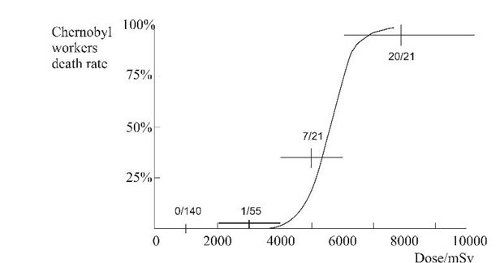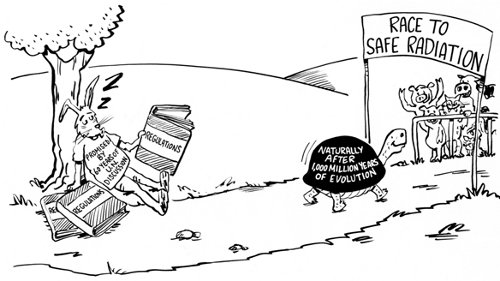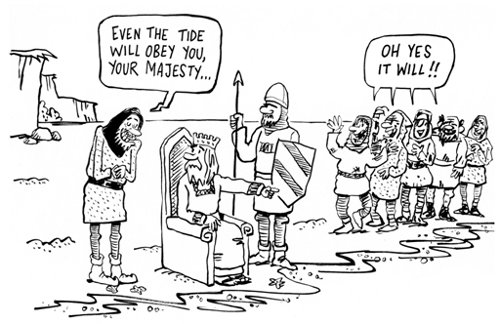Biology and radiation
You might expect nuclear energy to be far more dangerous to life than chemical energy because it can break delicate biological molecules with ease. But that would be too simplistic, for the only business of biology has been to evolve life forms that can cope with such attack and it has had more than 1000 million years of Darwinian selection to perfect its solution.
If, as with a virus or the bellicose behaviour of a neighbouring tribe, a threat can change or evolve, resistance may be problematic. But protection against a threat that never changes is almost always achievable given time. The effect of nuclear radiation is like that and life has found a near perfect set of overlapping protective mechanisms. These act subconsciously and work at the cellular level to protect inanimate as well animate forms of life. The same mechanisms are effective against the common all-garden attack by normal metabolic oxidation because that too results in a broad spectrum of broken molecules and disabled cells. They work in three ways:
- the basic design of life with its self organising reproduction, first at the level of individuals and then of replaceable cells with their own copies of DNA;
- the active defence against an attack by means of antioxidants, DNA repair enzymes, planned cell death and the action of the immune system, among others;
- the adaptive reaction, whereby cells are stimulated to build up extra supplies of antioxidants and enzymes and to modify their immune reaction in the light of recent attacks including those due to exercise and mental activity.
Advertisement
The adaptive reaction is called hormesis – we get used to moderate levels of sun when on holiday and get fit by taking regular exercise. In the same way moderate levels of nuclear radiation at low rates can improve health by stimulating the immune reaction.
But this stabilised response can be overloaded by a large and sudden radiation dose. This is a familiar feature of any stabilised system, for instance in the engineering of a car suspension or an audio amplifier. If hit by an input above a certain threshold in a short time the stabilisation fails and damage or distortion results. So in the case of radiation, how large is this threshold and what is a short time in this context? These questions are answered by examining evidence.
Dangerous doses of nuclear radiation

The mortality of early fire fighters at Chernobyl shown by crosses. The numbers give died/total in each dose range. The curve is for rats.
The diagram shows that most of the initial workers on the scene at Chernobyl who received more than 4000 mSv died, in fact from Acute Radiation Syndrome (ARS) not cancer, within a few weeks. Evidently there is a step, a risk threshold, somewhere between 2000 and 4000 mSv. However, many people are surprised to learn that any normal radiotherapy patient in the course of cancer treatment receives a dose ten times greater to large healthy parts of their body. The type of radiation used is no different and the dose may be 1000 mSv every day for five or six weeks. This tedious protracted treatment allows the healthy tissue to recover each day while the tumour itself, receiving double this dose, just fails to do so. This treatment works and shows that the repair time may be as short as a day -- without repair all patients would die before the end of their treatment, and would do too if 20 mSv per year were a sensible safety limit in the environment. This all shows that the public has access to their own evidence that such a safety limit is far too cautious and not based on sound science.
Traditional apprehension of the safety of radiation
The Cold War inculcated a dread of nuclear missile exchange based on the thousands of nuclear weapons deployed at that time. The sheer energy of a nuclear explosion creates a blast wave and a major fire storm effective for many kilometres from the detonation site. That would be relatively local on a world scale but the putative effect of the radiation released would be global and last for decades. Faced with marchers and demonstrations against nuclear war every government attempted to reassure the populace by setting radiation protection levels with extreme caution, in fact As Low As Reasonably Achievable (ALARA). But these were set by reference to naturally occurring doses, quite unrelated to risk, and were approved by the United Nations itself, to add extra gravitas. Although officially advisory it became very difficult for any nation not to implement them although they were about 1000 times more stringent than the safety guidelines of 1934, the year that Marie Curie died.
Although unrelated to any demonstrable risk they were given a semblance of scientific respectability by the so-called Linear No-Threshold hypothesis (LNT). In the name of special caution this sets aside all the mechanisms of Darwinian biology just discussed. Although academically discredited, this hypothesis still holds sway today at a regulatory and political level and was responsible for generating the inappropriate panic in Japan, in 2011 and since. Any safety limit established on a basis of established risk would give a figure that is As High As Relatively Safe (AHARS) -- that after all is the way in which we treat other risks, for instance the failure of a bridge or dam. It may be sensible to apply extra caution – the Precautionary Principle -- to the early use of any new technology, but with over a century of experience that hardly applies to nuclear.
Advertisement

The natural protection of life provided by slow evolution wins easily against regulation determined by committee, as illustrated by Aesop's Fable of the Race between the Tortoise and the Hare
Popular concern about nuclear radiation focusses in particular on the effect of internal radiation -- that is on radiation emitted over an extended period by radioactivity absorbed into the human body itself. In the Fukushima accident attention has centred on Caesium-137 which spreads throughout the body and has a 30-year radioactive life time, even though at Chernobyl no casualty could be linked to it. Any accident involving internal doses 1000 times greater than any measured at Fukushima would provide a convincing demonstration of any risk -- that is above a few million Bq. Such an accident happened at Goiania, Brazil, in 1987 when a Caesium-137 radiotherapy source of 20 TBq was stolen and broken open. It glowed with an enticing blue light and children painted themselves with it, spreading it around their home and kitchen, and their neighbours were invited in to see and admire. When finally resolved, 249 people had been contaminated, internally or externally. Four died of ARS including a girl with an internal radioactivity of 1000 million Bq. In addition 28 had serious burns requiring surgery. Since the accident two babies were born to women with a high internal dose, one with 0.2 million Bq who was pregnant at the time and another with 300 million Bq who gave birth 3 years 8 months later. No problems with the births has been reported. Now, more than 25 years later the total number of cancers reported with any possible link to the radiation is zero. How can this be? The internal radioactivity that spread throughout their bodies gave a dose protracted over many months which enabled the action of the repair and adaptive responses. Certainly the residents of Fukushima need have no concern whatever on account of Caesium-137 and the work of decontamination is just not necessary.

The sight of officials in protective clothing suggests danger and kills confidence
But residents of the contaminated regions of Fukushima have other worries. The sight of officials with meters and protective gear probing a children's playground would be enough to frighten the most hardened parent. Except within the plant itself this gear cannot be necessary. It may be an exercise in authority and "I am an official doing something important" but it certainly damages public confidence.
So how should we view the safety of radiation? With respect, experience and our own judgement, I suggest, the same as we do with UV in sunshine or fast traffic on the highway. It is certainly a mistake to believe that every authority and expert has the answer. The ancient story of King Canute illustrated that – his people thought that he could stop the tide coming in! Such ideas should be discouraged in a democracy.

Inthe story of King Canute the tide ignores the King's command to
retreat, for science and the laws of nature are deaf to the authority of governments, the United Nations, courts of law, majority votes
and the influence of money

Statistics, graphics and public persuasion
as used by Florence Nightingale
A justifiable safety limit
To start to build trust we should follow the example of Florence Nightingale. She collected data on how soldiers were dying in the Crimean War and then drew diagrams -- one is shown above -- to explain the need for better care of sick soldiers. She brought this evidence to the attention of the generals and politicians of the day. She succeeded in spite of the fact that those politicians would never have heard the word data before -- they were still learning about risk from the recent fate of the Charge of the Light Brigade!
Our objective is not dissimilar. We need to expose blind adherence to narrow judgements formed in another age – in our case the Cold War rather than the Napoleonic War. Faced with our task, how might Florence Nightingale have drawn a diagram to illustrate that current radiation regulations are inept and out of touch with modern medicine and biology? Perhaps with the simple diagram below which depicts doses received in a month as proportionate areas.

A set of simple areas comparing monthly doses (the ALARA limit is the small dot at the head of the arrow)
The rather small difference between the monthly dose to the tumour and to healthy tissue (factor 2) contrasts with the difference to the ALARA limit (factor 200,000). A conservative safety limit of 100 mSv per month is suggested. There is no established risk to health from such a dose rate, seen As High As Relatively Safe (AHARS). It is a conservative factor 200 less than the healthy tissue value frequently experienced by the patients in RT treatment and a 1000-fold relaxation of ALARA limit. It would reset safety levels to where they were in 1934 and suggest that up to ten full CT scans should be acceptable per month without concern. Such a new safety limit might be argued up or down by a factor two or three but a value different by a factor of more than ten would be unreasonable.
In Japan the entire scale of the evacuation, the condemnation of food and water, the clean up of the soil, the instruction of the population and the safety of the power plants should be reconsidered. The same paradigm shift should be considered world wide, for the same misunderstanding has occurred everywhere and it caused unnecessary social suffering following the accidents at Chernobyl and Goiania too.
Overcoming the current widespread primitive fear of nuclear ought to be easier than overcoming such a fear of fire in prehistoric times – and it is no less important for the future of civilisation. The environmental effect of the use of fossil fuels continues to escalate and time may be short. If another Fukushima accident should occur, like last time it would be less serious than the frequent disasters that follow the pursuit of fossil fuels with their significant loss of life. It is unlikely that climate change can be limited without a major switch to nuclear energy, and accepting nuclear, in a democracy at least, requires a radically new appreciation of science in society, not only by politicians and the media, but by scientists too.

An image of the unbalanced and narrow perspective currently taken by the United Nations and other authorities – and the consequences which voters in some countries are starting to notice
This is the second in a two part series on the risks and benefits of nuclear power. You can read the first here.
The author is a member of the SARI group, Scientists for Accurate Radiation Information http://radiationeffects.org/ This article is based on an invited lecture given at the Second AGORA Conference, Tokyo. and at the British Chamber of Commerce in Japan, 8 and 9 Dec. 2013. A more extended discussion with references may be found in the book Radiation and Reason available from http://www.radiationandreason.com together with other recent articles in Kindle, ePub, Japanese and Chinese editions, also available from Amazon.